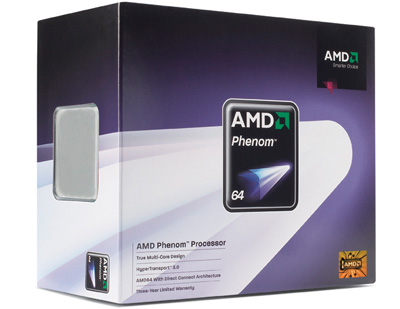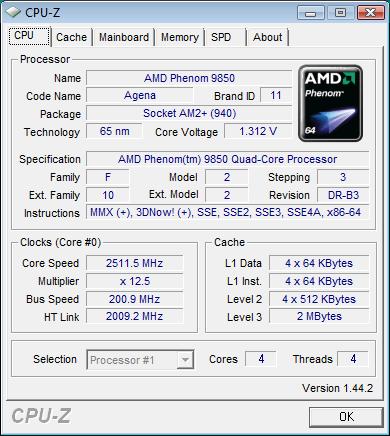AMD Phenom 9850 2.5GHz quad core processor (UK)

The first time that AMD launched their Phenom flagship, it really didn’t go well. It was believed that AMD would create a whole new era with this model added to the portfolio. But shortly if its launch rumors started to spread about a flaw in the processor that in some cases would make the computer bluescreen. The infamous TLB Buffer error in the processor did not make things any easier for a product already under pressure. Under pressure? Well, Intel has for a long time been ahead in regard to performance. It’s been like this for some years and it makes it more difficult for other manufacturers to sell their products at a more reasonable price.
INTRODUCTION:
The first time that AMD launched their Phenom flagship, it really didn’t go well. It was believed that AMD would create a whole new era with this model added to the portfolio. But shortly if its launch rumors started to spread about a flaw in the processor that in some cases would make the computer bluescreen. The infamous TLB Buffer error in the processor did not make things any easier for a product already under pressure. Under pressure? Well, Intel has for a long time been ahead in regard to performance. It’s been like this for some years and it makes it more difficult for other manufacturers to sell their products at a more reasonable price.

THE PRODUCT:
The Phenom X4 processor is the first Quad Core processor from AMD, but not the first revision that we’ve seen. This is the B3 revision without the TLB error.
All processors (including Intel’s Core 2 Dua / Quad) are full of errors, but these are flaws that to a large extent can be fixed through micro code updates via the BIOS or Windows updates from Microsoft.
It’s quite normal, but rarely something that is spoken about because these updates are kept out of the spotlight. The TLB error, on the other hand, could not be fixed and that’s why it received such a wide publicity.
A solution to this issue was discovered. But it required the deactivation of some cache functions, which had an impact on performance. Another issue with the processor was its poor overclocking performance; even if just barely above the default.
The people at AMD quickly realized the extent of the problem, and a new revision designed to solve this issue was made, namely the B3 revision, which we will have a look on today.
SPECIFICATIONS:
Let’s take a closer look at the specifications:
In CPU-Z we find a 2GHz HT Link and the processor has a 2MB L3 cache, as well as a indication that this is the B3 revision.
|
Processor |
AMD Phenom X4 Quad-Core |
|
Model |
9850 |
|
Operating Mode 32 Bit |
Yes |
|
Operating Mode 64 Bit |
Yes |
|
Revision |
B3 |
|
(MHz) |
2500 |
|
Volt |
1.20/1.25V |
|
Max Temps (C) |
61\'C |
|
Watt |
125 W |
|
L1 Cache (KB) |
128 |
|
L1 Cache |
4 |
|
L2 Cache (KB) |
512 |
|
L2 Cache |
4 |
|
L3 Cache (KB) |
2048 |
|
Fabrikationsstørrelse |
65nm |
|
Socket |
AM2+ |
|
Max temperatur |
70 grader |
|
Hukommelses Controller |
Integreret 128 bit controller |
Here we see an illustration that generally covers the design of the AMD Phenom processor with its four cores, cache and its interface:

You can read much more about the specifications via this link.
One of the bigger news, other than the four cores, is of course the new DDR2 memory controller.


Seneste processor
-
-
16 sepprocessor
AMD Ryzen AI 7 PRO 360 spottet
-
04 sepprocessor
Intel scorer stor AI-chip kunde
-
04 sepprocessor
Eksklusiv-Intel fabrikationsforretning skuffer
-
30 augprocessor
Intel forbedrer Lunar Lake latency
-
29 augprocessor
Stort performance boost til Ryzen CPU'er
-
28 augprocessor
Intel-aktier kan falde i kampen med TSMC og NVIDIA
-
28 augprocessor
AMD hævdes at være blevet hacket









